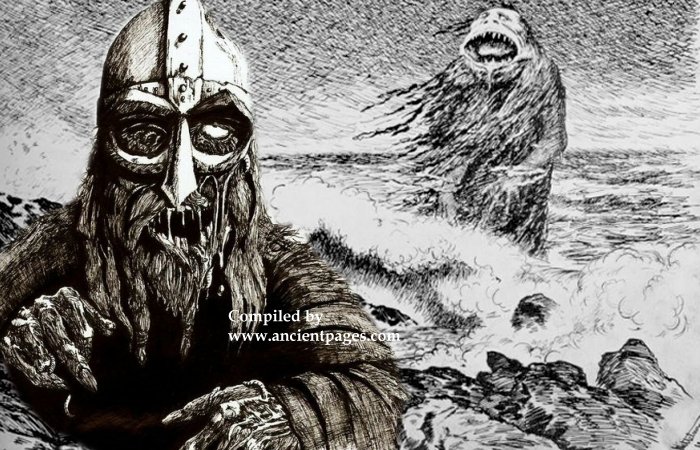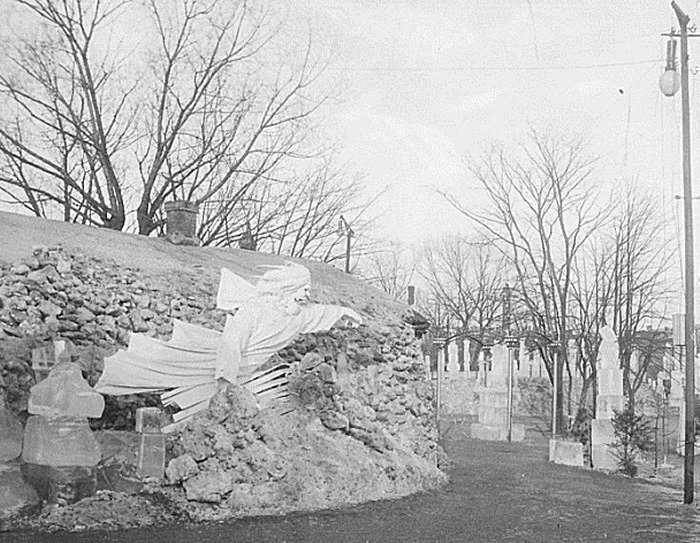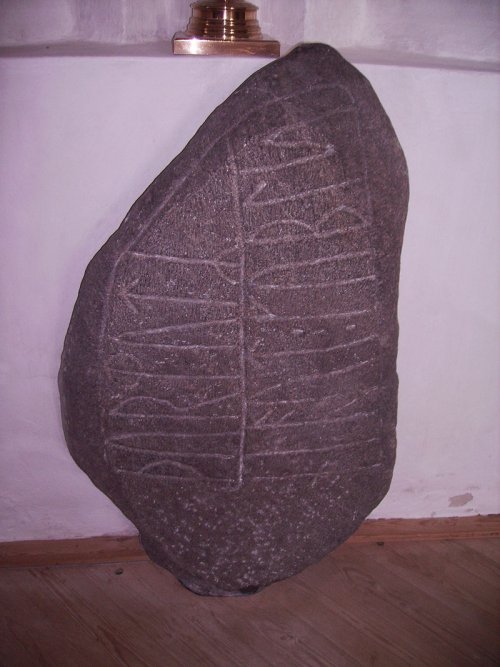Draugr – Vikings Feared This Ugly Living Dead With Prophetic Visions
Ellen Lloyd - AncientPages.com - In Norse mythology, there are many references to a creature known as Draugr, often described as a fearsome, ugly living dead who would rise from the grave and make life miserable for people.
Archaeological evidence shows Vikings feared the draugr so much that they took the necessary precautions to prevent the draugr from returning to the world of the living.
The draugr was by no means a stupid creature. The creature knew the secrets of the past and future. There were many reasons why Norse people feared the arrival of this horrible being.
What Was A Draugr?
The origin of the word 'Draugr' is not entirely clear. Some scholars think it comes from the same root as dream or Traum in modern German, but others trace it to the Indo-European' dhreugh' (harm, deceive). It's also possible there is a strong connection between the Old Norse' draugr' and the Old English 'draco.' We can identify the draugr as a human ghost we find in Norse people's beliefs.
In the Norse Sagas, the draugr (plural, draugar) is mentioned several times, and descriptions of this fearsome creature vary. Also, we shouldn't forget that there are different types of them. The Draugar lived in graves and guarded treasures buried with them.
These beings could rise from the grave and increase their size at will. The size attributed to this being was a way of expressing the vast strength of the creature. The draugr was not an ignorant creature. It could exhibit supernatural powers and possessed knowledge of the past and future. In Norse society, a female shaman known as Völva was attributed with the ability to foretell future events. However, in Norse sagas, stories describe how some draugar mastered prophetic visions.
An ice sculpture representing a draugr. Image credit: Christoffer Gade Rude (1839-1901) -Oslo Museum: image no. OB.F18000 (Byhistorisk samling), via oslobilder.no. - Public Domain
People feared the draugr because it displayed abnormal behavior, violent tendencies, and a hostile attitude toward humans. To the Norse people, a draugr was like a piece of wood.
In the sagas, there is not a single description of a bleeding draugr. One could find out whether a person had turned into it or was still human by checking if blood came from a wound.
This hideous being had lost human appearance and the capability to behave like humans and lacked social abilities. Yet, it could move, talk, and even recite poems. Some draugar were also associated with the gift of speech and prophetic visions. Sometimes, they could come in large groups to attack a settlement, but not everyone was interested in terrorizing humans. Many of these creatures enjoyed staying in their burial mound.
Who Could Become A Draugr?
Like many other ancient civilizations, the Vikings did not consider death to be the end of a person's existence. The concept of an afterlife played a significant role in Norse society. Sometimes, the afterlife seemed more real than the people living in it.
Norse scholars have identified two different sets of beliefs related to the fate of the dead. Some believed that life continued in Valhalla, the halls of the gods; others thought there was a continuation of life within the grave-mound. These two Norse afterlife beliefs are archaeologically supported.
The Nørre Nærå Runestone is interpreted as having a "grave binding inscription" used to keep the deceased in its grave. Credit: Søren Møller
A Viking warrior's ultimate dream was to enter Valhalla, God Odin's gigantic and majestic chamber of the fallen heroes – warriors and mighty chiefs – who died in heroic deaths in battle. But not everyone could enter Valhalla.
The person was not dead when a deceased body was placed in a grave. The 'dead' body was believed to become animated with strange life and power and could turn into a draugr. Anyone who had been buried could do it, too.
Archaeological Evidence Reveals Vikings Feared The Draugr
Archaeologists have discovered runestones that mention the Draugr. There is an inscription on the Karlevi Runestone on top of a burial mound: "Danger! Ghosts!"
The belief in the existence of draugr is ancient. Dated to the late 10th century, the Karlevi Runestone is the oldest runestone on the island of Öland, Sweden. Archaeologists discovered that the dead person's weapons had been made impossible to use in some Viking graves.
We have previously discussed complex ancient Viking funeral traditions and rituals.
By burning a body, one could be sure the deceased did not turn into a draugr.
Many relics in ancient tombs reveal that the type of burial a Viking received depended on his importance in society. When a Viking died, he could either be buried or burned. Powerful Viking chiefs who received ship burial could never come back as a draugr, and they were on their way to Valhalla, but Vikings buried in mounds risked turning into this horrible and feared creature.
Updated on February 16, 2024
Written by - Ellen Lloyd – AncientPages.com
Copyright © AncientPages.com All rights reserved. This material may not be published, broadcast, rewritten or redistributed in whole or part without the express written permission of AncientPages.com
More From Ancient Pages
-
 A 2,500-Year-Old Planned City In Tarighat, Chhattisgarh, India
Civilizations | Oct 8, 2014
A 2,500-Year-Old Planned City In Tarighat, Chhattisgarh, India
Civilizations | Oct 8, 2014 -
 Face-To-Face Encounter With Young Scottish Soldier Who Lived And Died Over 300 Years Ago
Archaeology | Dec 23, 2017
Face-To-Face Encounter With Young Scottish Soldier Who Lived And Died Over 300 Years Ago
Archaeology | Dec 23, 2017 -
 On This Day In History: ‘Edict Of Nantes’ About Freedom Of Religion Issued By Henry IV – On Apr 13, 1598
News | Apr 13, 2017
On This Day In History: ‘Edict Of Nantes’ About Freedom Of Religion Issued By Henry IV – On Apr 13, 1598
News | Apr 13, 2017 -
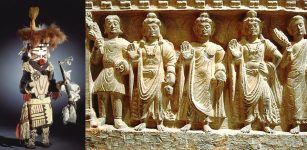 Mysterious Zuni Indians And Japanese People May Be Related – Did Buddhist Monks Reach North America In 1350?
Civilizations | Dec 26, 2017
Mysterious Zuni Indians And Japanese People May Be Related – Did Buddhist Monks Reach North America In 1350?
Civilizations | Dec 26, 2017 -
 Ivan The Terrible: Military Arsenal Unearthed Near Moscow
Archaeology | Jan 2, 2016
Ivan The Terrible: Military Arsenal Unearthed Near Moscow
Archaeology | Jan 2, 2016 -
 Ancient Artifacts With Foreign Inscriptions And Unknown Signs Discovered In The American Southwest Reveal An Epic Story
Featured Stories | Jul 11, 2024
Ancient Artifacts With Foreign Inscriptions And Unknown Signs Discovered In The American Southwest Reveal An Epic Story
Featured Stories | Jul 11, 2024 -
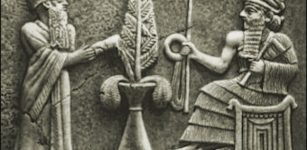 Ur-Nammu – Popular And Accomplished Ruler Of Sumer
Civilizations | Oct 31, 2016
Ur-Nammu – Popular And Accomplished Ruler Of Sumer
Civilizations | Oct 31, 2016 -
 Underground Civilizations – True Rulers Of Earth – Part 1
Ancient Mysteries | May 7, 2019
Underground Civilizations – True Rulers Of Earth – Part 1
Ancient Mysteries | May 7, 2019 -
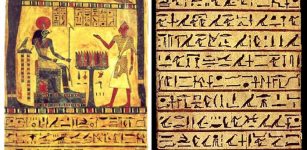 Strange History Of Stele Of Ankh-ef-en-Khonsu – ‘Stele Of Revealing’ Gave Birth To Thelema, A New Religion
Artifacts | Apr 3, 2018
Strange History Of Stele Of Ankh-ef-en-Khonsu – ‘Stele Of Revealing’ Gave Birth To Thelema, A New Religion
Artifacts | Apr 3, 2018 -
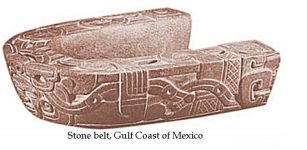 Millennia Old Ceremonial Stone Belt And Maya Pok-A-Tok Ball Game
Ancient Traditions And Customs | Nov 28, 2017
Millennia Old Ceremonial Stone Belt And Maya Pok-A-Tok Ball Game
Ancient Traditions And Customs | Nov 28, 2017 -
 Ancient Tombs Arranged In The Image Of A Galaxy Discovered In Sudan
Archaeology | Jul 8, 2021
Ancient Tombs Arranged In The Image Of A Galaxy Discovered In Sudan
Archaeology | Jul 8, 2021 -
 Top 10 Archaeological Discoveries 2023
Archaeology | Dec 27, 2023
Top 10 Archaeological Discoveries 2023
Archaeology | Dec 27, 2023 -
 Ancient Burial Chambers Decorated With Mythological Figures Of Hercules, Medusa, Eros – Unearthed In Bursa, Turkey
Archaeology | Feb 21, 2017
Ancient Burial Chambers Decorated With Mythological Figures Of Hercules, Medusa, Eros – Unearthed In Bursa, Turkey
Archaeology | Feb 21, 2017 -
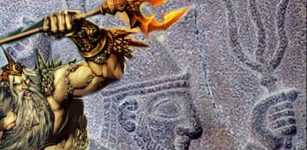 Trident: Powerful Religious Symbol Found In Many Ancient Cultures
Ancient Symbols | Dec 4, 2019
Trident: Powerful Religious Symbol Found In Many Ancient Cultures
Ancient Symbols | Dec 4, 2019 -
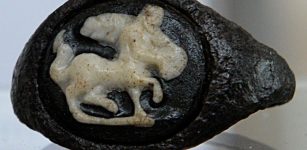 Roman Treasures Unearthed At Ancient Site Of Tiel, Netherlands
Archaeology | Apr 2, 2017
Roman Treasures Unearthed At Ancient Site Of Tiel, Netherlands
Archaeology | Apr 2, 2017 -
 On This Day In History: Mount Fuji Erupted – On Dec 16, 1707
News | Dec 16, 2016
On This Day In History: Mount Fuji Erupted – On Dec 16, 1707
News | Dec 16, 2016 -
 Ancient Egyptians Had A Different Definition Of ‘Foreigners’
Ancient History Facts | Apr 14, 2018
Ancient Egyptians Had A Different Definition Of ‘Foreigners’
Ancient History Facts | Apr 14, 2018 -
 Why Are Statues Of Mythical Yeti Dividing People In The Himalayas?
Featured Stories | Feb 18, 2020
Why Are Statues Of Mythical Yeti Dividing People In The Himalayas?
Featured Stories | Feb 18, 2020 -
 Xochicalco: Stunning Ruins Of Sacred City Linked To Maya and Aztecs Civilizations
Featured Stories | Feb 26, 2018
Xochicalco: Stunning Ruins Of Sacred City Linked To Maya and Aztecs Civilizations
Featured Stories | Feb 26, 2018 -
 Legend Of Tarenyawagon Who Came From The Heavens And Ascended To The Stars In His Fast Flying Shining Canoe
Ancient Mysteries | Feb 25, 2019
Legend Of Tarenyawagon Who Came From The Heavens And Ascended To The Stars In His Fast Flying Shining Canoe
Ancient Mysteries | Feb 25, 2019

